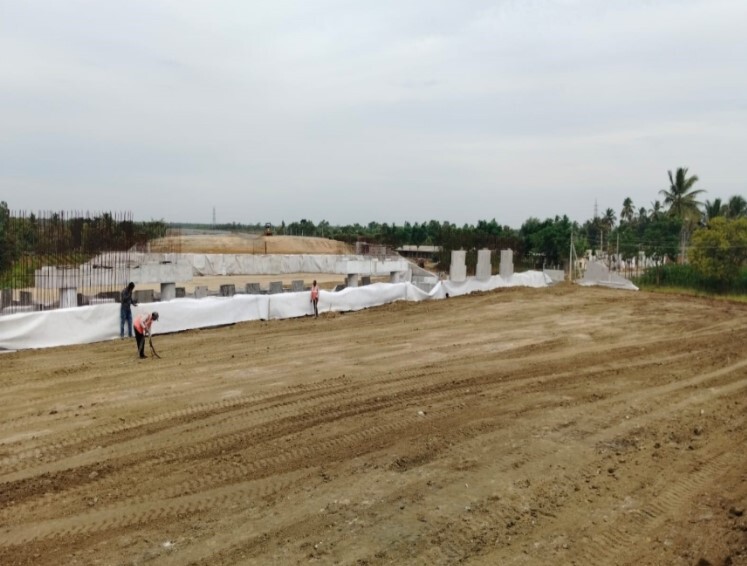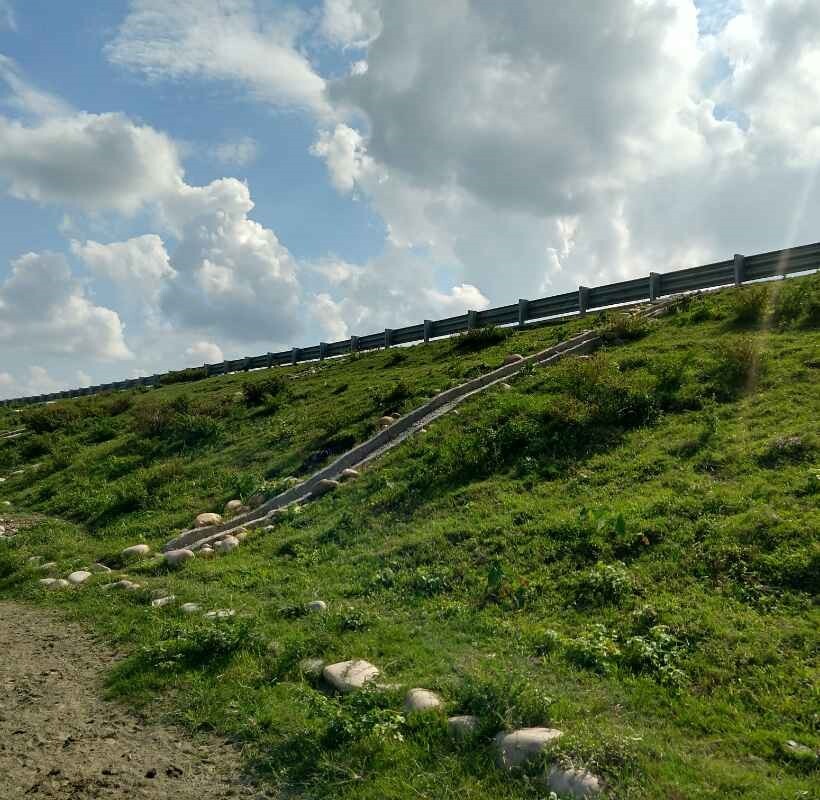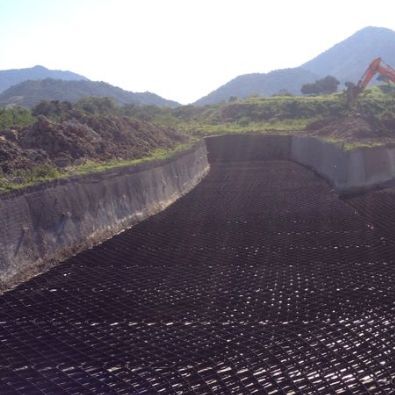What is permeability of soil?
Soil permeability is a measure of its capacity to allow liquid and/or gases to pass through it. It is an inherent property of soil. In the context of civil engineering, however, the most important element of permeability is related to water transmission. Soil mechanics, the branch of engineering that studies the physical properties of soil, explains how soil transmits fluids (water or air) through its pores, affecting the structural stability and several underlying engineering decisions that have to be made based on this single factor. This blog discusses what soil permeability means, the factors that influence it, its significance in civil construction, how to measure it, and the role geosynthetic materials play in influencing and controlling it.
The concepts of in-plane and cross-plane permeability are essential for understanding how water flows through soil and geosynthetic materials.

- In-plane permeability, also referred to as in-plane flow, is a critical parameter for assessing the efficiency of drainage layers. It is the permeability of a material in a direction parallel to its surface. The in-plane permeability of soil is essential for the design and functionality of drainage systems, ensuring that water moves efficiently through the drainage layer and preventing water logging or structural issues. This type is critical in materials that are subjected to lateral water flow.
- Cross-plane permeability refers to the ability of a soil or geosynthetic material to allow water to pass through it in a direction perpendicular to its plane. In geotextile design for drainage and filtration applications, the cross-plane permeability of the geotextile should generally be greater than the vertical permeability of the adjacent soil to ensure adequate water flow without clogging or excessive head buildup. This type of permeability is often used to assess the movement of water under load, as in the case of foundations and embankments. Intrinsic permeability is expressed in units like darcy, while hydraulic conductivity (often referred to as permeability in engineering practice) determined from tests like the constant head and falling head test is expressed in velocity units (e.g., m/s).
How does soil permeability impact structures?
Soil permeability has a bearing on (pun intended!) the design, stability and safety of structures built on top, in, or under soil. Since soil is sensitive to how water passes through it, the rate of water flow and its effects on pore pressure must be accounted for during design.
Soil permeability governs 4 key aspects of the structural design and planning:
1. Settlement and consolidation: When permeability is high, consolidation settlement happens faster under a given load. In contrast, low permeability soils take longer to settle, prolonging consolidation periods. While designing, we also need to consider the moisture content of the soil itself, alongside the terrain –for example, coastal areas versus arid regions or mountainous regions.
2. Seepage and drainage: Permeability controls how water moves through soil, which in turn determines seepage patterns and drainage design. This has a ripple effect on the performance of stability of dams, canals, and levees, and other water-retaining structures.
- Permeable soils: Offer easy drainage, while also having potential for erosion or piping.
- Impermeable soils tend to have poor drainage alongside risk for water accumulation and uplift.
- Anisotropic soils (permeability varies with direction) lead to complex seepage patterns, with unexpected drainage paths
Through the table below, we have broken down the varied effects that permeability alone has on different industrial applications.
Industrial applications that require drainage |
Effects on seepage and drainage based on permeability |
|---|---|
Tailing dams |
Affects stability. Low permeability can lead to high pore pressures, while high permeability can lead to internal erosion (piping) failures. |
Ports and container terminals |
Influences the stability of wharves, quays, and foundation soils –impacting structural integrity of port facilities. |
Landfills and waste containment structures |
Controls the migration of leachate and gases |
Mining pits and underground mines |
Regulates groundwater inflows, stability, and safety in mining operations. |
Coastal structures (seawalls, groins, breakwaters) |
Influences structural resilience to coastal erosion and wave action |
Reservoirs and impoundments |
Determines the rate of water loss through seepage, which impacts the reservoir's efficiency and long-term water retention. |
Buried pipelines and utility infrastructure |
Impacts risk of water damage, corrosion, and structural degradation. |
Paved roads and highways |
Alters subgrade moisture levels, influencing pavement settlement, stability, and overall performance |
3. Soil strength and stress: Permeability governs the rate at which pore water pressure changes in response to loading. This in turn impairs or improves the soil’s load bearing capacity, foundation design, slope stability, and the overall interaction between soil and structures. Depending on the soil type, we adjust for slope strength, and other factors.
4. Material Selection and design: Permeability is an underlying factor that guides decisions on backfill materials, drainage systems, and foundation design; all of which are critical to ensuring optimal performance, safety, and durability.
- Permeable soils:
- Require drainage considerations (filters, geotextiles)
- Potential for corrosion or degradation of materials
- Impermeable soils:
- Demand waterproofing measures (membranes, coatings)
- Potential for material selection based on chemical resistance
- Soils with varying permeability or chemistry:
- Require specialised materials or designs
- Potential for innovative solutions (e.g., permeable reactive barriers)
What affects soil permeability?
Soil permeability is a complex property influenced by factors that essentially relate to the soil’s structure and composition. A soil is considered saturated when all of its voids are occupied by water. If only some of the voids contain water, the soil is partially saturated. Water movement occurs through these voids rather than through the soil particles themselves, and this flow is driven by differences in hydraulic head.
Soil type: The first most important factor is the soil type itself since each of them have different permeabilities. Sand, silt, and clay–each differ from each other in the amount of water that can pass through them. Sandy soils generally exhibit high permeability, while clayey soils have low permeability.
- Particle size and distribution: The second factor is the size, shape, and texture of soil particles and how water interacts with them. Larger particles, such as sand, create larger pore spaces, facilitating easier water flow, whereas smaller particles, like clay, have tighter spaces that restrict flow.
- Void ratio: The void ratio, or the volume of voids in the soil, dictates the space available for water movement. While not directly proportional, a higher void ratio generally leads to greater permeability because there are more and larger pathways for water to flow.
- Degree of saturation: The amount of water occupying the voids impacts the soil’s permeability to water. Partially saturated soils generally exhibit lower hydraulic conductivity to water compared to fully saturated soils because entrapped air can obstruct flow paths.
- Compaction: While compaction is beneficial for increasing soil strength and stability, it achieves this by reducing the soil’s void ratio. This process directly reduces permeability, which in turn decreases drainage and water infiltration
- Stratification: The layering of soil, whether from construction or natural deposition, determines permeability. In layered soils, water tends to flow more horizontally than vertically. In a soil deposit with a silt layer between sand and clay, the silt’s permeability can be 10 times that of the clay and one-tenth of the sand’s. This variation impacts the soil’s overall behaviour. Other soils, like sand and clay, also show this difference in permeability. Knowing these differences is necessary for designing safe structures for dams and embankments.
- Organic matter: Organic matter works by modifying soil structure and composition, impacting its hydraulic conductivity and permeability. By forming stable aggregates, organic matter enhances soil porosity and pore connectivity, leading to increased permeability and improved drainage. In clay-rich soils, organic matter flocculates clay particles, creating a more open and permeable soil fabric that facilitates water infiltration and percolation.
- Pore connectivity: Referring to the degree to which pores are interconnected, in a porous medium, leading to water flow. In earthen dams, the connectivity of pores dictates the rate of water seepage while in case of landfills, it restricts or eases the movement of leachate and gases.
- Presence of cracks or macropores: Cracks and large pores can significantly increase permeability by providing direct pathways for water to flow through the soil.
What is Darcy’s law?
Darcy’s Law is a fundamental empirical equation describing fluid flow through porous media. It benefits flow problems in porous media such as soil, sand, and rock. It expresses the relationship between flow rate, hydraulic head gradient, and permeability.
Q = KA (h/L)
Where,
Q = Flow rate
K = Soil permeability or hydraulic conductivity
A = Cross-sectional area of flow
h = Hydraulic head difference
L = Length of the flow path
Darcy’s law implies:
- Direct proportionality: The flow Q is directly proportional to h/L, the hydraulic gradient, and A, the cross-sectional area. If you increase either the hydraulic gradient or the cross-sectional area, the flow rate will also increase.
- Influence of permeability: Hydraulic conductivity (K) is a property of both the soil and the fluid passing through it. The larger its value, the greater the ease with which a fluid can flow through. Therefore, a more porous material will yield greater flow rates for the same hydraulic gradient and cross-sectional area.
Applications of Darcy’s Law:
- Groundwater flow: Darcy’s law finds applications in modeling groundwater flow through aquifers.
- Soil filtration: This will give information on the flow of contaminants through the soil during filtration.
- Hydraulic engineering: To design a drainage system or a dam, one needs to know how fluid flows through porous media.
- Environmental remediation: Useful when estimating the rate of contaminant transport in soils and groundwater.
What is the importance of soil permeability?
From structural failure, contamination to drainage issues, permeability is a tool that has to be used well in civil engineering.
- Foundation stability: The rate of consolidation settlement depends on permeability. In compressible, low-permeability soils like clay, settlement occurs slowly over a long period. In contrast, in soils with high permeability like sand, settlement happens almost immediately upon loading. Water infiltration can also reduce the shear strength of foundation soils or lead to volume changes. Impervious soils, in turn, obstruct water infiltration in the ground, so water is still held under the surface. As a natural consequence, hydrostatic pressure develops, resulting in soil uplift forces. This is also typically a phenomenon in retaining walls where hydrostatic pressure may build up.
- Slope stability: Low-permeability soils can trap water within a slope, leading to increased pore water pressure, reduced effective stress, and thereby increasing the risk of landslides or slope failures. Conversely, highly permeable soils or engineered drainage systems generally promote slope stability by facilitating drainage. However, highly permeable soils can be susceptible to internal erosion (or piping) under high seepage forces. In low-permeability soils, the inability for water to drain quickly under load is the primary cause of increased pore pressure, typically has a more significant destabilizing effect on the slope than the added weight of the trapped water.
- Drainage systems: Permeable materials are essential for roads, highways, and airports to drain and avoid degradation of the subgrade. These materials can absorb and pass water, which prevents the subgrade from becoming saturated and losing its strength, thereby protecting the pavement from structural damage like rutting and cracking.
- Groundwater contamination: The permeability of the soil beneath and adjacent to canals is critical for controlling seepage. If the canal water is contaminated or the surrounding groundwater is polluted, high-permeability soils can accelerate the spread of contaminants. The soil’s permeability dictates how quickly contaminants’ spread through groundwater. High-permeability soils move contaminants rapidly, so the water sources closest to them are the first ones to get polluted. To manage seepage and prevent erosion in canals, geotextiles are used for separation and filtration. However, to prevent water loss, canal linings require an impermeable liner, such as a geomembrane, to block flow.
- Waste disposal: Impermeable materials are layered at the different levels of waste disposal facilities to stop the leachate from seeping or permeating through the liner. Leachate is a contaminated solution that transfers pollution to the ground water and through landfills. Specifically, impermeable clay liners are used in landfills to keep leachate from seeping into the ground, thus saving the environment.
Role of geosynthetic materials in soil permeability
Geosynthetic materials either increase or decrease the extent of soil permeability, based on the project, and soil it’s being used for. Broadly, there are three ways in which geosynthetics get used:
- Improving permeability: Geonets and geocomposites allow fluid movement and transmission, increasing porosity and drainage.
- Reducing permeability: Geomembranes act as barriers, preventing water infiltration and fluid transmission.
- Filtering: Geotextiles trap fine particles, preventing blockages and ensuring clear fluid flow.
As a result, geosynthetics serve 5 common uses:
- Increase drainage and fluid flow
- Prevent water infiltration and fluid escape
- Filter and separate soil particles
- Provide soil stabilization which can help maintain the integrity of drainage systems
- Prevent erosion and soil loss
Applications of Strata’s products in soil permeability
Using geosynthetic materials in fields such as rock mechanics, filtration, drainage, coastal engineering, or landfills showcase proven control of the permeability issue.
- Drainage systems: Geosynthetic materials are typically placed in the drainage layers of roads, highways, and airports to help with drainage. In doing so, they provide a dedicated, high-capacity void space within the geosynthetic for water to drain efficiently, which in turn prevents waterlogging and the resulting pavement damage and potholes.
- Landfill liners: Landfill liners are made of geosynthetic materials, which prevent leachate migration, a liquid that can contaminate groundwater. Leachate is thus trapped behind the impermeable membrane before it has a chance to evade the containment zone and enter the clean surroundings.

- Erosion control: They are installed on the surface of slopes to shield the soil from the erosive effects of rain and wind, preventing soil loss and helping to establish vegetation.
- Groundwater remediation: In groundwater remediation systems, geosynthetics serve multiple roles. Geotextiles are crucial for filtration and separation, preventing soil layers from mixing while allowing water to pass. In containment systems, they also serve as a protective cushion for geomembrane liners, safeguarding them from punctures. For surface applications, geosynthetics can provide erosion control, protecting the remediation site from wind and rain.
- Reservoir liners: To prevent leaking, reservoirs can be lined with geomembranes. The reservoir liner safeguards the structure’s integrity by containing the water and preventing seepage into the underlying ground.
By having insight into the grounds of soil permeability and the potential of geosynthetic materials, civil engineers and construction professionals can create efficient and eco-friendly structures. Contact Strata Geosystems team of experts today!


